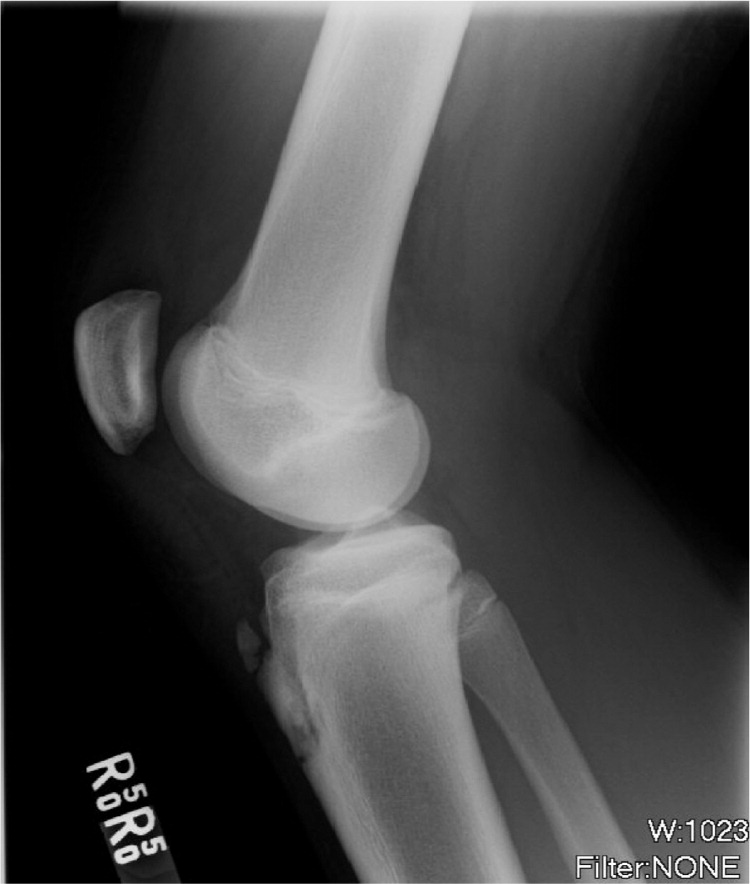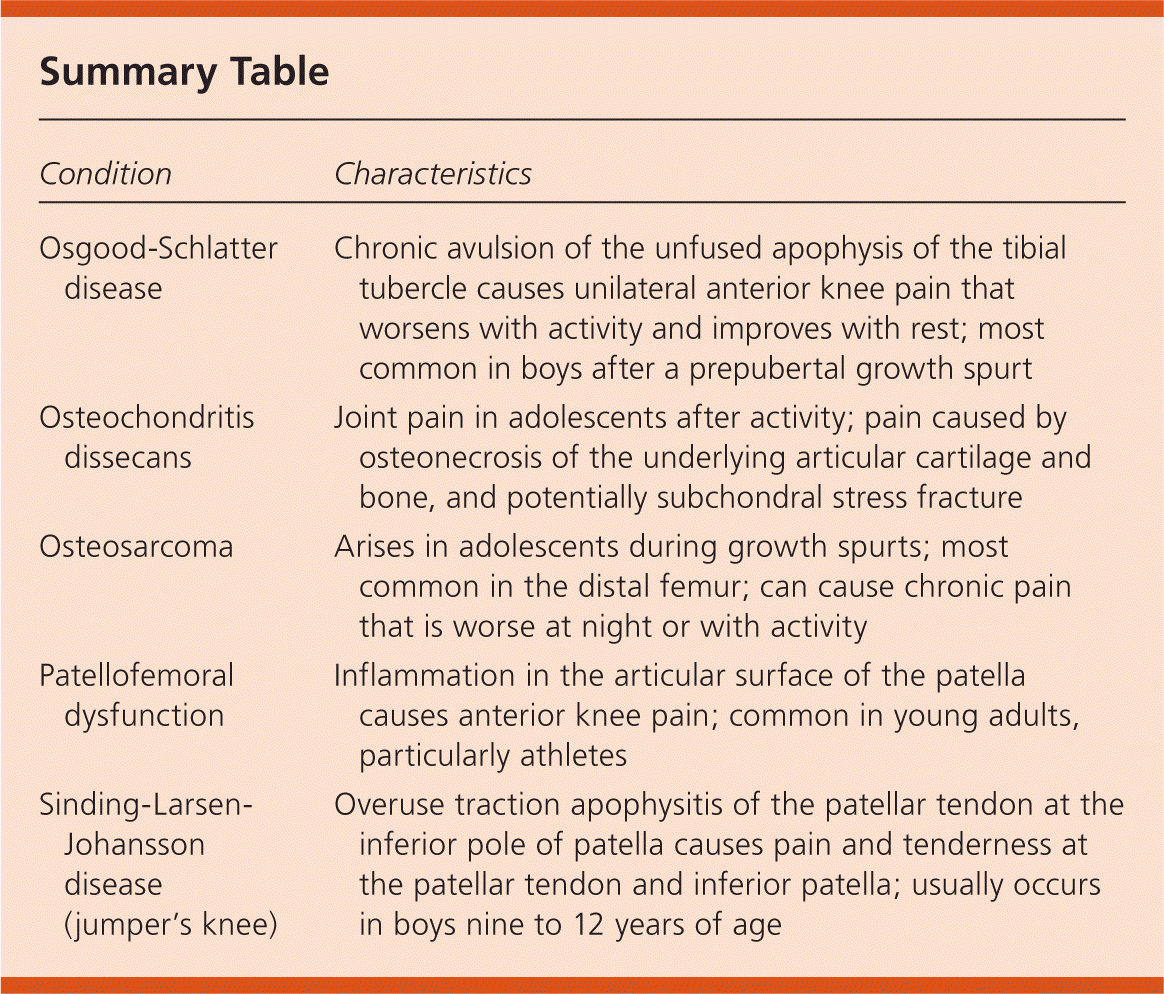
Am Fam Physician. 2012;86(6):569-570
Author disclosure: No relevant financial affiliations to disclose.
A 14-year-old girl presented with several weeks of intermittent right knee pain. The pain worsened after activity and improved with rest. She had not tried any over-the-counter analgesics. She played volleyball, but not around the time the pain began.
Physical examination revealed a normal-appearing right knee. There was no varus or valgus deformity, and her gait was normal. There was no effusion or erythema. She had tenderness over the patellar tendon and the tibial tubercle. Range of motion was normal and similar to the left side. The ligaments and menisci were intact. Radiography of the knee was performed (see accompanying figure).

Question
Discussion
The answer is A: Osgood-Schlatter disease. The patient's radiograph showed a prominent and fragmented anterior tibial tubercle with adjacent soft tissue swelling, which is consistent with this diagnosis.
Osgood-Schlatter disease, which is also known as osteochondrosis of the tibial tuberosity, is an overuse injury caused by chronic avulsion of the unfused apophysis of the tibial tubercle. The proximal tibial physis usually closes during adolescence. As it ossifies, it is prone to avulsion because it changes from stronger fibrocartilage to weaker columnar cartilage before becoming bone.1 With repetitive contraction of the quadriceps muscle (e.g., from jumping, squatting, using stairs), the patellar tendon begins to pull away from the tibial tubercle.2
Osgood-Schlatter disease is most common in boys after their prepubertal growth spurt. Patients present with unilateral anterior knee pain that worsens with activity and improves with rest.3 Symptoms are bilateral in about 25 to 30 percent of patients.4 The disease is more common in children with a sibling who has had it and in children with a history of Sever disease (calcaneal apophysitis).5
Physical examination findings are tenderness and prominence over the tibial tubercle. Knee extension or squatting may reproduce the pain. Both the hamstring and quadriceps may be tight. Radiographs are not diagnostic, but may help exclude other causes of knee pain. They can show calcification and thickening of the patellar tendon, irregular ossification of the tibial tubercle, and overlying soft tissue swelling.1
Conservative management is indicated in most cases because Osgood-Schlatter disease is self-limited and resolves when the growth plate closes. Treatment consists of controlling pain with ice and analgesics, and physical therapy. If symptoms are severe, patients may need to decrease activity to allow healing of the microfractures.3 Athletes may need to refrain from sports for two to three months. Patients and parents should be educated that the tibial prominence may persist after symptoms are gone, which may make kneeling difficult.4
Osteochondritis dissecans causes joint pain in adolescents resulting from a discrete area of damage to subchondral bone. The pain is caused by osteonecrosis of the underlying cartilage and bone, and potentially subchondral stress fracture. The inability to fully extend the leg is a helpful clinical sign, but the condition is diagnosed radiographically.6
An osteosarcoma is a malignant tumor in bone, most commonly the distal femur, that arises in adolescents during growth spurts. It can cause chronic pain that is worse at night or with activity.7
Patellofemoral dysfunction is a common cause of anterior knee pain in young adults, particularly athletes. It is caused by inflammation in the articular surface of the patella and is worsened by pressure on the anterior patella. Pain is worse with climbing, jumping, or sitting.2
Sinding-Larsen-Johansson disease (jumper's knee) is an overuse traction apophysitis of the patellar tendon at the inferior pole of the patella, not the tibial tubercle. It causes pain and tenderness at the patellar tendon and inferior patella. It usually occurs in boys nine to 12 years of age.1

| Condition | Characteristics |
|---|---|
| Osgood-Schlatter disease | Chronic avulsion of the unfused apophysis of the tibial tubercle causes unilateral anterior knee pain that worsens with activity and improves with rest; most common in boys after a prepubertal growth spurt |
| Osteochondritis dissecans | Joint pain in adolescents after activity; pain caused by osteonecrosis of the underlying articular cartilage and bone, and potentially subchondral stress fracture |
| Osteosarcoma | Arises in adolescents during growth spurts; most common in the distal femur; can cause chronic pain that is worse at night or with activity |
| Patellofemoral dysfunction | Inflammation in the articular surface of the patella causes anterior knee pain; common in young adults, particularly athletes |
| Sinding-Larsen-Johansson disease (jumper's knee) | Overuse traction apophysitis of the patellar tendon at the inferior pole of patella causes pain and tenderness at the patellar tendon and inferior patella; usually occurs in boys nine to 12 years of age |
